
# What is a Meteorological Station?
A meteorological station, often referred to as a weather station, is a facility equipped with instruments and tools designed to observe and record atmospheric conditions. These stations play a crucial role in weather forecasting, climate research, and environmental monitoring.
## Key Components of a Meteorological Station
Meteorological stations typically include several essential instruments to measure various weather parameters:
– Thermometer: Measures air temperature.
– Barometer: Records atmospheric pressure.
– Hygrometer: Determines humidity levels.
– Anemometer: Measures wind speed and direction.
– Rain gauge: Tracks precipitation amounts.
– Pyranometer: Measures solar radiation.
## Types of Meteorological Stations
Meteorological stations can be categorized based on their location and purpose:
### 1. Surface Weather Stations
These are the most common type, installed on the ground to measure surface-level weather conditions.
### 2. Upper-Air Stations
These stations use weather balloons (radiosondes) to collect data from higher altitudes.
### 3. Automated Weather Stations (AWS)
Modern stations that automatically collect and transmit data without human intervention.
### 4. Marine Weather Stations
Located on buoys or ships to monitor oceanic weather conditions.
## Importance of Meteorological Stations
Meteorological stations serve numerous critical functions:
– Weather forecasting and warnings
– Climate change research
– Agricultural planning
– Aviation safety
– Disaster preparedness
– Environmental monitoring
## Data Collection and Transmission
Modern meteorological stations often use automated systems to collect and transmit data in real-time. This information is sent to weather centers where it’s analyzed and used for various purposes, including:
– Creating weather maps
– Developing forecast models
– Issuing severe weather alerts
– Supporting scientific research
## The Future of Meteorological Stations
With advancements in technology, meteorological stations are becoming more sophisticated. Many now incorporate:
– Remote sensing technology
– Satellite communication
– IoT connectivity
– Advanced data analytics
– Machine learning for improved forecasting
These innovations are making weather data more accurate and accessible than ever before, helping societies better prepare for and respond to changing weather patterns and extreme events.
Keyword: what is meteorological station